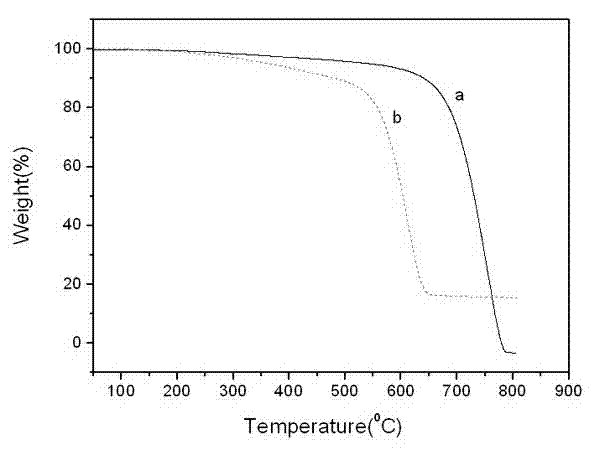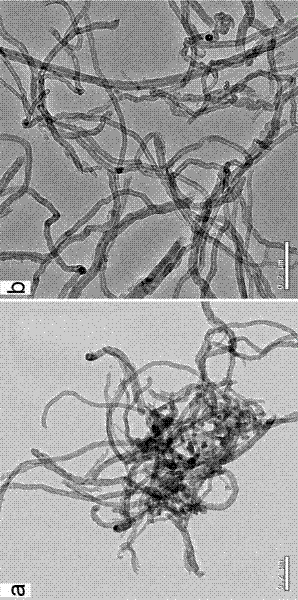Surface modification method of carbon nanotube, carbon nanotube and application thereof
A technology of carbon nanotubes and modification methods, applied in chemical instruments and methods, other chemical processes, alkali metal oxides/hydroxides, etc., can solve problems such as weak interaction, poor adsorption effect, and lack of functional groups , to achieve the effect of high reuse rate, easy separation and enhanced adsorption performance
- Summary
- Abstract
- Description
- Claims
- Application Information
AI Technical Summary
Problems solved by technology
Method used
Image
Examples
Embodiment 1
[0021] Add 1.0 g of multi-walled carbon nanotubes into 100 g of concentrated nitric acid, and heat to reflux for 24 hours at 100° C. with stirring. After cooling to room temperature, high-speed centrifugal separation, the solid was washed with deionized water to a pH value of 7, and vacuum-dried at 50° C. for 12 hours to obtain acidified multi-walled carbon nanotubes.
[0022] Mix 200 mg of acidified carbon nanotubes, 40 g of dimethylformamide and 100 g of thionyl chloride, and ultrasonically disperse for 10 minutes. The reaction was then stirred at a temperature of 70°C for 20 hours. Excess thionyl chloride was removed by distillation under reduced pressure. The solid product was filtered with a nylon membrane, washed with tetrahydrofuran, and vacuum-dried at 50° C. for 24 hours to obtain acyl chloride carbon nanotubes.
[0023] Add 100 mg of carbonyl chloride carbon nanotubes and 100 mg of sodium p-aminobenzenesulfonate to 5 g of dimethylformamide, and ultrasonically dispe...
Embodiment 2
[0026] Add 1.0 g of single-walled carbon nanotubes into 200 g of concentrated nitric acid, and heat to reflux for 12 hours at 80° C. with stirring. After cooling to room temperature, high-speed centrifugation, the solid was washed with deionized water to a pH value of 7, and vacuum-dried at 70° C. for 10 hours to obtain acidified multi-walled carbon nanotubes.
[0027] Mix 200 mg of acidified carbon nanotubes, 10 g of dimethylformamide and 40 g of thionyl chloride, and ultrasonically disperse for 30 minutes. The reaction was then stirred at a temperature of 100° C. for 30 hours. Excess thionyl chloride was removed by distillation under reduced pressure. The solid product was filtered with a nylon filter membrane, washed with tetrahydrofuran, and dried under vacuum at 60°C for 18 hours to obtain acyl chloride carbon nanotubes.
[0028]Add 100 mg of acyl chloride carbon nanotubes and 200 mg of sodium p-aminobenzenesulfonate into 10 g of dimethylformamide, and disperse ultrason...
Embodiment 3
[0031] Add 1.0 g of single-walled carbon nanotubes into 150 g of concentrated nitric acid, and heat to reflux for 18 hours at 90° C. with stirring. After cooling to room temperature, high-speed centrifugation, the solid was washed with deionized water to a pH value of 7, and vacuum-dried at 70° C. for 6 hours to obtain acidified multi-walled carbon nanotubes.
[0032] Mix 200 mg of acidified carbon nanotubes, 30 g of dimethylformamide and 60 g of thionyl chloride, and ultrasonically disperse for 30 minutes. The reaction was then stirred at a temperature of 90°C for 25 hours. Excess thionyl chloride was removed by distillation under reduced pressure. The solid product was filtered with a nylon filter membrane, washed with tetrahydrofuran, and dried under vacuum at 70°C for 12 hours to obtain acyl chloride carbon nanotubes.
[0033] Add 100 mg of acyl chloride carbon nanotubes and 150 mg of sodium p-aminobenzenesulfonate into 15 g of dimethylformamide, and disperse ultrasonica...
PUM
 Login to View More
Login to View More Abstract
Description
Claims
Application Information
 Login to View More
Login to View More - R&D
- Intellectual Property
- Life Sciences
- Materials
- Tech Scout
- Unparalleled Data Quality
- Higher Quality Content
- 60% Fewer Hallucinations
Browse by: Latest US Patents, China's latest patents, Technical Efficacy Thesaurus, Application Domain, Technology Topic, Popular Technical Reports.
© 2025 PatSnap. All rights reserved.Legal|Privacy policy|Modern Slavery Act Transparency Statement|Sitemap|About US| Contact US: help@patsnap.com



